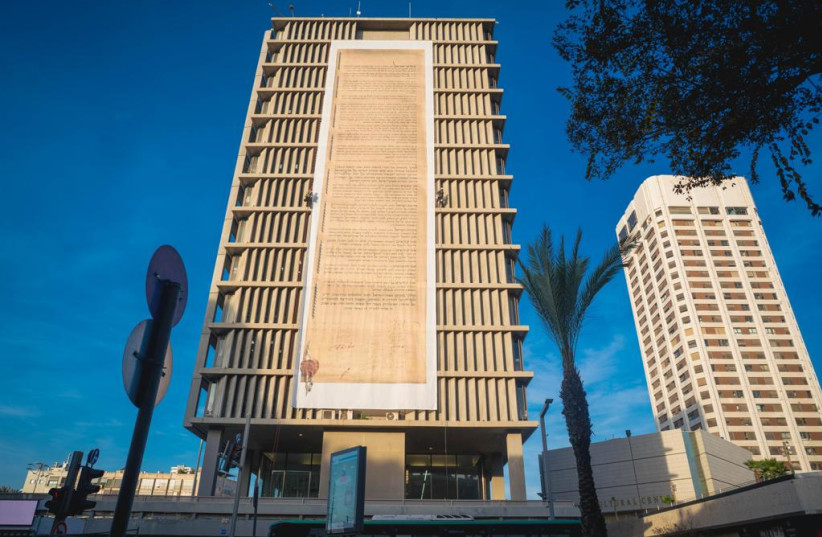Perhaps more than at any time since its creation, people today are talking about Israel’s Declaration of Independence. Neil Rogachevsky and Dov Zigler recently published Israel’s Declaration of Independence: The History and Political Theory of the Nation’s Founding Moment, just in time to inform the discussion.
The authors are not Israelis, and their analysis focuses heavily on American parallels. Rogachevsky teaches Israel studies at Yeshiva University in New York, and Zigler is chief international economist at the Element Capital hedge fund in New York.
They present a strong analysis of the political theory behind writing a declaration of independence, explaining that the American founding fathers believed that the British were trampling their basic rights, so they centered the American Declaration and their new political setup on the basic rights of individuals. Israel’s Declaration, on the other hand, is largely based on the rights of the collective, the Jewish people. The Declaration argued that, like other nations, Jews had the right to sovereignty in their ancestral territory.
What Israel's Declaration of Independence is still missing
The book analyzes early drafts of the Israel’s Declaration that were ultimately not adopted, comparing them to David Ben-Gurion’s final draft. One early draft hewed very closely to the language of the American Declaration, even including the phrase “life, liberty, and the pursuit of happiness.” Some drafts focused more on the fact that the United Nations had granted Jews the right to set up a state, seeing that as the strongest basis for declaring independence. Some included more emphasis on history; others more specific references to Jewish texts; yet others emphasized the socialist-Zionist idea that Jewish pioneers (chalutzim) had come back to the land and “redeemed it,” thus earning the right to declare a state.
In the last few hectic days before the Declaration, the authors point out, the leaders of the Yishuv, the Jewish community in the land, had more important concerns – defending themselves from an attack that could have brought a quick end to the state and to the lives of Jews living there. Despite the large role that the Declaration of Independence now plays in Israeli society and the changing ways that the Israeli court system has used it (also analyzed in the book), the document itself was not the result of a long process reflecting a broad consensus. Ben-Gurion himself is quoted as saying, not too prophetically, that they did not have to create a document that schoolchildren would recite a hundred years after 1948.

Unfortunately, the book’s discussion of the Declaration in a Jewish framework suffers from inaccuracies. For example: “Abraham, the Mishnah relates, departed from Ur Kasdim and set out to Canaan in order to found a new tribe. In so doing, the Mishnah adds, Abraham had to destroy his father’s gods” (p. 186, and a related claim on p. 11). None of this is in the Mishna. The Hebrew word for values is arachim, not erekhim (p. 221). The much-discussed phrase in the Declaration, Tzur Yisrael (the Rock of Israel), which many see as referring to God, does not appear in the book of Psalms (p. 188).
But they provide useful analyses of important questions, including discussions of words or concepts that were present in earlier drafts of the Declaration but absent in the final draft. Some early drafts referred to specific borders of the new state (based on United Nations resolutions of the time). Ultimately, Ben-Gurion, like the drafters of the American Declaration of Independence, chose not to mention borders, probably because, like them, he was uncertain what those borders would be.
The authors also point out that the word “democratic” or “democracy,” describing the state, is not in the final version, although it appeared in a number of earlier drafts. The authors say that the significance of this omission is unclear. Certainly, the drafters envisioned a state with an elected government; indeed, the pre-state yishuv was already governed by elected bodies.
But perhaps this aspect of the Declaration has some significance to the vigorous debate raging in Israeli society today about what democracy really means: Is it a system where ultimate power is in the hands of an elected legislature, or is it a system where human rights, particularly the rights of minorities, are protected? The first meaning is not reflected anywhere in the Declaration. The second is: “The State of Israel... will foster the development of the country for the benefit of all its inhabitants; it will be based on freedom, justice, and peace as envisaged by the prophets of Israel; it will ensure complete equality of social and political rights to all its inhabitants irrespective of religion, race, or sex; it will guarantee freedom of religion, conscience, language, education, and culture; it will safeguard the Holy Places of all religions; and it will be faithful to the principles of the Charter of the United Nations.”
Israel’s Declaration of Independence
By Neil Rogachevsky and Dov Zigler
Cambridge University Press
300 pages; $39.99
